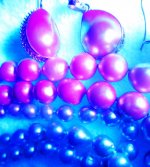It is one thing to be mistaken, it is quite another to intentionally misled.
The seller cannot be mistaken. After all, they concocted this wild tale, then staged photos. So it's not just words, these are actions.
jilliin32 said:
I smashed the one i was keeping with a hammer so you can all see they are real natural pearls. Photo number 6 the left side in the middle is the piece that still has the pebble or sand stuck to it. The next photo i flipped it over so you could see....its not the easiest thing to capture. Each little broken piece the curvature gets smaller and smaller. As you know that is how it is produced by the oyster. I dont know how many of you have smashed a pearl or seen one smashed but its interesting. It looks more iridescent on each inside layer of the inside wall. You can always smash one to see for yourself as well. If you are willing to lose one. The last photo you can see the layers on the piece in the front. That is also the one with the grain.
Douglas posted this video of a mollusk's ability to slough extraneous sand. Without considering all the possibilities how sand may be implicated in nature, the video basically underlies that farms do not use sand, ever, for any reason in minor, no less mass production.
Categorically, sand at the nuclei of a natural pearl is infinitely rare and nonexistent in cultured pearls.
We know they're not SoC pearls. That leaves CFWP's. I'm not aware of any farms in China nucleating with sand either, other than the souffle mud process (though not being claimed in the case).
Secondly, if it actually were a grain of sand that somehow found it's way into the extrapallial space, nacre would not simply smash away from it as shown in the picture. Although subsequent layers may be smashed away, it would be infinitely impossible to smash away all the first layer in one or two smacks. It would require a microscopic cleaning to remove nacre cemented by surface tension and into cracks and fissures.
The seller is a deliberate fraud.

